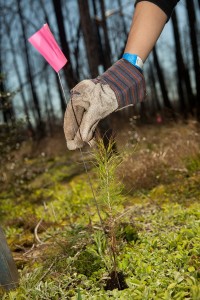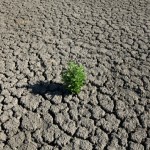How New Legislation Could Help Texas Go Native Again

Photo courtesy of Texas A&M University/Forest Service
A Texas A&M Aggie plants a Loblolly Pine seedling in Bastrop State Park after the 2011 wildfires. New legislation could expand the supply of native Texas seeds.
In the mid-1500s, Comanche Indians roamed what would eventually become Central Texas, Karankawa Indians fished where Galveston would one day sit and hardly an invasive or exotic plant existed in the state. But since then, many of Texas’ native plants have taken a beating.
Legislation introduced by a Texas lawmaker could help reseed Texas with the hardy native plants and grasses of that bygone era, and return the landscape along Texas’ highways and construction sites to a native state.
“I would describe this agenda as one [of] trying to protect our natural heritage,” Rep. Mike Villarreal, D-San Antonio, who has filed two native seed bills, tells StateImpact Texas.
The problem right now, Villarreal says, is that road construction projects and energy exploration leave a muddy mess in their wake. That torn-up land must be reseeded, but that is oftentimes done with non-native species.
Those foreign plants are less able to handle Texas’ extremes. Some use more water than native plants and many are dying now due to drought. And when the non-native plants thrive, they can creep off of highways and construction sites and invade neighboring farms and private land, Villarreal says.
One of the bills, HB 1135, would create a Native Seed Committee tasked with developing a ten-year plan to ratchet-up production of native seeds and their use in restoration projects. The committee would consist of several people appointed by top lawmakers and the heads of relevant state agencies, such as the Texas Parks and Wildlife Department and Texas Department of Transportation.

Texas A&M University/Forest Service
A park ranger and a Texas A&M Aggie plant native Loblolly Pine seedlings in Bastrop State Park after the wildfires. A Texas lawmaker has filed two bills that address the need for native seeds in Texas.
A second bill, HB 1116, would create a Texas Native Seed Competitive Grant Program to help a qualifying entity, like a public university, with restoration projects (at places like roadside construction projects, energy exploration sites and wildlife habitats) that utilize native plants.
For funding the grant, “the ballpark is a million dollars to see fruitful expansion,” Villarreal said.
Bill Nieman, a native seed grower, says its good that the state government is talking about the issue of native plants and seeds, but he thinks more can be done.
Nieman is the owner and operator of Native American Seed, and specializes in native Texas seeds. He’s has been in the land mangement business for 35 years and has grown native Texas seeds for eighteen years.
Nieman says the benefits of using native seeds are plain to see. They are drought-resistant, provide the food and habitat required for native wildlife and live in harmony with other native plants and animals.
“It’s so clear that you don’t have to go to college to figure it out. These natives know how to live here without any extra care. They evolved here,” Nieman tells StateImpact Texas.
Nieman, who says he has not consulted with Villarreal on either of the native seed bills, thinks that the legislation could do more. Increasing awareness of native plants and their uses would drive an increase in demand, Nieman says.
“I don’t know that simply making a bunch more seeds is going to change how people treat the land,” Nieman says.
And it can be hard to predict when and what type of native seeds will be needed in various parts of the state.
Following the Bastrop wildfires, the Texas Parks and Wildlife Department was tasked with replanting the Lost Pines forest that had burned down.
The Texas Forest Service’s Loblolly Pine seed stockpile, which consisted of about 1,000 pounds of seeds that had been stored for nearly two decades in a pharmacy freezer, was three weeks away from being destroyed when the fires struck.
Now those seeds are being used to replant the Loblolly forest. A large group of Texas A&M Aggies spent the weekend planting some 30,000 trees in Bastrop State Park.

